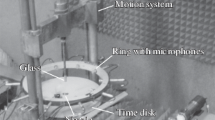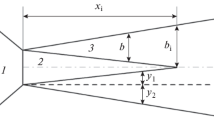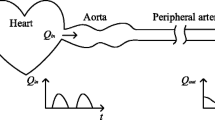Abstract
An acoustic model of a larger human blood vessel is developed. This model takes into account the main features of the acoustic generation and propagation of noise in the human chest from the source (turbulent pressure fluctuations in blood flow) to a receiver resting on the skin, and allows the consideration of a simple stenotic narrowing in the vessel. The low Mach number turbulent wall pressure models of Corcos, Chase, Ffowcs Williams, and Smol'yakov and Tkachenko are used to describe random sources in the vessel. The relationships obtained permit one to analyse the dependence of the resultant acoustic field in the thorax on the parameters of the blood flow and the vessel, and show the possibility of finding characteristic signs of the presence of a stenosis by comparison of noise fields from intact and diseased arteries.
Similar content being viewed by others
References
Giddens, D.P., Mabon, R.F. and Cassanova, R.A., Measurements of disordered flow distal to subtotal vascular stenosis in the thoracic aorta of canines. Circ. Res. 39 (1976) 112–119.
Tobin, R.J. and Chang, I.D., Wall pressure spectra scaling downstream of stenoses in steady tube flow. J. Biomech. 9 (1976) 633–640.
Clark, C., Turbulent velocity measurements in a model of aortic stenosis. J. Biomech. 9 (1976) 677–687.
Clark, C., Turbulent wall pressure measurements in a model of aortic stenosis. J. Biomech. 10 (1977) 461–472.
Khalifa, A.M. and Giddens, D.P., Analysis of disorder in pulsatile flows with application to poststenotic blood velocity measurement in dogs. J. Biomech. 11 (1978) 129–141.
Gosling, R.G. and King, D.H., Continuous wave ultrasound as an alternative and complement to X-rays in vascular examinations. In: Reneman, R.S. (ed.), Cardiovascular Applications of Ultrasound. Elsevier, New York (1974) pp. 266–282.
Fitzgerald, D.E. and Carr, J., Doppler ultrasound diagnosis and classification as an alternative to arteriography. Angiology 26 (1975) 283–288.
Lees, R.S. and Dewey, C.F., Jr., Phonoangiography: A new noninvasive diagnostic method for studying arterial disease. Proc. Nat. Acad. Sci. 67 (1970) 935–942.
Fredberg, J.J., Pseudosound generation at atherosclerotic constrictions in arteries. Bull. Math. Biol. 36 (1974) 143–155.
Fredberg, J.J., Origin and character of vascular murmurs: Model studies. J. Acoust. Soc. Amer. 61 (1977) 1077–1085.
Duncan, G.W., Gruber, J.O., Dewey, C.F., Jr., Myers, G.S. and Lees, R.S., Evaluation of carotid stenosis by phonoangiography. New Eng. J. Med. 293 (1975) 1124–1128.
Pitts, W.H., III and Dewey, C.F., Jr., Spectral and temporal characteristics of post-stenotic turbulent wall pressure fluctuations. ASME J. Biomech. Engrg. 101 (1979) 89–95.
Gavriely, N., Palto, Y. and Alroy, G., Spectral characteristics of normal breath sounds. J. Appl. Physiol. 50 (1980) 307–314.
Kraman, S.S., Determination of the site of production of respiratory sounds by subtraction phonopneumography. Amer. Rev. Resp. Dis. 122 (1980) 303–314.
Charbonneu, G., Raccineux, J.L., Subraud, M. and Tuchais, E., An accurate recording system and its use in breath sounds spectral analysis. J. Appl. Physiol. 55 (1983) 1120–1127.
Cohen, A. and Landsberg, D., Analysis and automatic classification of breath sounds. IEEE +wans. Biomed. Engrg. BME-31 (1984) 585–590.
Vovk, I.V., Grinchenko, V.T., Krasnyi, L.G. and Makarenkov, A.P., Breath sounds: Recording and classification problems. Akust. Zhurn. 40 (1994) 50–56 [in Russian].
Makarenkov, A.P. and Rudnitskii, A.G., Diagnosis of lung pathologies by two-channel processing of breath sounds. Akust. Zhurn. 41 (1995) 272–277 [in Russian].
Borisyuk, A.O., Noise generation by flow in pipes in presence of wall obstructions. Rep. Acad. Sci. Ukr. 11 (1996) 66–70 [in Ukrainian].
Borisyuk, A.A., Noise generated by steady flow in human blood vessels in presence of stenoses. Bionics 27-28 (1998) 144–151 [in Russian].
Kim, B. and Corcoran, W.K., Experimental measurement of turbulence spectra distal to stenosis. J. Biomech. 7 (1974) 335–342.
Wang, J., Tie, B., Welkowitz, W., Semmlow, J.L. and Kostis, J.B., Modeling sound generation in stenosed coronary arteries. IEEE Trans. Biomed. Engrg. 37 (1990) 1087–1094.
Wodicka, G.R., Stevens, K.N., Golub, H.L., Growalho, E.G. and Shanon, D.C., A model of acoustic transmission in the respiratory system. IEEE Trans. Biomed. Engrg. 36 (1989) 925–933.
Wodicka, G.R., Stevens, K.N., Golub, H.L. and Shanon, D.C., Spectral characteristics of sound transmission in the human respiratory system. IEEE Trans. Biomed. Engrg. 37 (1990) 1130–1134.
Vovk, I.V., Zalutskii, K.E. and Krasnyi, L.G., Acoustic model of the human respiratory system. Akust. Zhurn. 40 (1994) 762–767 [in Russian].
Corcos, G.M., The resolution of pressure in turbulence. J. Acoust. Soc. Amer. 35 (1963) 192–199.
Borisyuk, A.O. and Grinchenko, V.T., Vibration and noise generation by elastic element excited by a turbulent flow. J. Sound Vibr. 204 (1997) 213–237.
Martin, N.C. and Leehey, P., Low wavenumber wall pressure measurements using a rectangular membrane as a spatial filter. J. Sound Vibr. 52 (1977) 95–120.
Young, D.F., Fluid mechanics of arterial stenoses. J. Biomech. Engrg. 101 (1979) 157–175.
Mirolyubov, S.G., Hydrodynamics of stenosis. Modern Probl. Biomech. 1 (1983) 73–136 [in Russian].
Blake, W.K. (ed.), Mechanics of Flow-Induced Sound and Vibration (two volumes). Academic Press, New York (1986) 954 pp.
Ffowcs Williams, J.E., Boundary-layer pressures and the Corcos model: A development to incorporate low-wavenumber constraints. J. Fluid Mech. 125 (1982) 9–25.
Smol'yakov, A.V. and Tkachenko, V.M., Models of pseudosound turbulent wall pressure field and experimental data. Akust. Zhurn. 37 (1991) 1199–1207 [in Russian].
Chase, D.M., Modeling the wavevector-frequency spectrum of turbulent boundary layer wall pressure. J. Sound Vibr. 70 (1980) 29–67.
Rights and permissions
About this article
Cite this article
Borisyuk, A. Noise Field in the Human Chest Due to Turbulent Flow in a Larger Blood Vessel. Flow, Turbulence and Combustion 61, 269–284 (1998). https://doi.org/10.1023/A:1026462706646
Issue Date:
DOI: https://doi.org/10.1023/A:1026462706646




